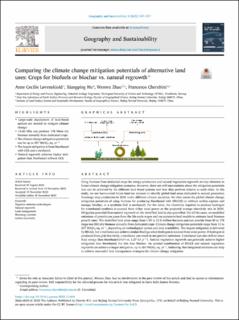| dc.contributor.author | Løvenskiold, Anne Cecilie | |
| dc.contributor.author | Hu, Xiangping | |
| dc.contributor.author | Zhao, Wenwu | |
| dc.contributor.author | Cherubini, Francesco | |
| dc.date.accessioned | 2023-03-13T09:01:15Z | |
| dc.date.available | 2023-03-13T09:01:15Z | |
| dc.date.created | 2023-01-13T09:09:27Z | |
| dc.date.issued | 2022 | |
| dc.identifier.citation | Geography and Sustainability. 2022, 3 (4), 347-357. | en_US |
| dc.identifier.issn | 2096-7438 | |
| dc.identifier.uri | https://hdl.handle.net/11250/3057848 | |
| dc.description.abstract | Using biomass from dedicated crops for energy production and natural vegetation regrowth are key elements in future climate change mitigation scenarios. However, there are still uncertainties about the mitigation potentials that can be achieved by the different land-based systems and how they perform relative to each other. In this study, we use harmonized future land use datasets to identify global land areas dedicated to second generation bioenergy crop production in 2050 under different climate scenarios. We then assess the global climate change mitigation potentials of using biomass for producing bioethanol with (BECCS) or without carbon capture and storage, biochar, or a synthetic fuel (e-methanol). For the latter, the electricity required to produce hydrogen for e-methanol synthesis is sourced from either wind power or the projected average electricity mix in 2050. Mitigation potential from natural regrowth on the identified land is also quantified. For all the cases, we modelled emissions of greenhouse gases from the life-cycle stages and use parameterized models to estimate local biomass growth rates. The identified land areas range from 1.95 to 13.8 million hectares and can provide from 30 to 178 mega ton (Mt) dry biomass annually from dedicated crops. Climate change mitigation potentials range from 11 to 257 MtCO2-eq. yr−1, depending on technological option and land availability. The largest mitigation is delivered by BECCS, but e-methanol can achieve similar findings when hydrogen is sourced from wind power. If hydrogen is produced from grid electricity, e-methanol can result in net positive emissions. E-methanol can also deliver more final energy than bioethanol (4.04 vs. 1.27 EJ yr−1). Natural vegetation regrowth can generally achieve higher mitigation than bioethanol, but less than biochar. An optimal combination of BECCS and natural vegetation regrowth can achieve a larger mitigation, up to 281 MtCO2-eq. yr−1, indicating that integrated solutions can help to achieve successful land management strategies for climate change mitigation. | en_US |
| dc.language.iso | eng | en_US |
| dc.publisher | Elsevier | en_US |
| dc.rights | Navngivelse 4.0 Internasjonal | * |
| dc.rights.uri | http://creativecommons.org/licenses/by/4.0/deed.no | * |
| dc.title | Comparing the climate change mitigation potentials of alternative land uses: Crops for biofuels or biochar vs. natural regrowth | en_US |
| dc.title.alternative | Comparing the climate change mitigation potentials of alternative land uses: Crops for biofuels or biochar vs. natural regrowth | en_US |
| dc.type | Peer reviewed | en_US |
| dc.type | Journal article | en_US |
| dc.description.version | publishedVersion | en_US |
| dc.source.pagenumber | 347-357 | en_US |
| dc.source.volume | 3 | en_US |
| dc.source.journal | Geography and Sustainability | en_US |
| dc.source.issue | 4 | en_US |
| dc.identifier.doi | 10.1016/j.geosus.2022.11.004 | |
| dc.identifier.cristin | 2106160 | |
| cristin.ispublished | true | |
| cristin.fulltext | original | |
| cristin.qualitycode | 1 | |

